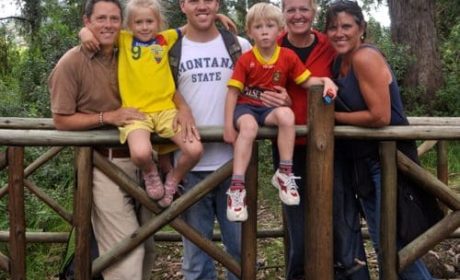We’re so excited about our new relationship with Grandparents.com. We’ll be publishing selected articles on multigenerational travel from their site to share with our readers and they’ll be sharing some of our articles with their readers. Today, Ludmilla Alexander shares a fun idea on how to take the grandkids on a safari adventure without stepping foot out of the United States.
“I see a giraffe, Grandma, I see a giraffe!” shouts our 3-year-old grandson, Timmy, upon waking up in a safari tent at a 400-acre animal preserve.
“It’s eating leaves off the tree,” observes his 5-year-old sister, Kara, jumping from her bunk bed. “Boy, do giraffes have long necks!”

So begins our safari adventure, not on the Serengeti Plains in Africa, but in the Sonoma Wine Country of northern California. Grandfather Jim and I have taken the little people for an overnight excursion to a privately owned animal preserve called Safari West in Santa Rosa.
Peter and Nancy Lang bought the property in 1989 to house their herd of elands (African antelopes), which they were breeding for various zoos. As the years passed, the menagerie grew to include giraffes, Watusi cattle, zebras, wildebeests, Cape buffalo, lemurs, cheetahs, ostriches and an aviary of exotic birds. Today, more than 60,000 young and old visitors arrive annually to take tours, stay overnight in luxury tents, enjoy barbecue meals, and shop in an unusual gift store.
For our grandchildren, the two-and-one-half hour guided jeep tour through the preserve is as exciting as waking up with the animals is. We drive up and down a rutted dirt road into several fenced areas, searching for various herds roaming the oak-studded hillsides. Kara cheers when a baby zebra scampers up a steep embankment to be with its mother. She falls in love with Holly, a cute little Watusi calf, that is being hand-raised in an enclosed paddock, and is surprised to learn that its relatives have six-foot horns on their heads.
Timmy, on the other hand, is fascinated by a sleek cheetah, roaming back and forth in its own fenced area, constantly staring at us. During the night, Timmy asks me to “shut off the crickets” so he can sleep.
While all types of animals fascinate children, keep in mind the following:
• Make sure your grandchildren are not afraid of large animals or the sounds they make.
• Hold their hands tightly so they don’t pet the animals or fall out of a bouncing jeep.
• Bring along water and snacks if the tour is long. Make sure everyone uses the bathroom beforehand.
• For overnight stays, pack the children’s favorite blankets and stuffed animals. If electricity is available, take along a nightlight. If not, turn on a flashlight.
In the past 40 years, large and small safari parks have opened around the nation. Some are part of large zoos and theme parks. Others are privately owned but open to the public. Consider these for your own domestic safari:
Florida
Lion Country Safari in West Palm Beach is home to 900 animals, including lions, white rhinos, chimpanzees, zebras, and giraffes. It has a drive-through preserve and a walk-through entertainment area, called Safari World, where a petting zoo, carousel, boat rides, aviaries, and camel rides are located. The KOA (Kampgrounds of America) site is close enough to the animals to let you hear the roar of lions in the early morning.
Disney’s Animal Kingdom in Orlando offers Kilimanjaro Safaris to watch live giraffes, zebras, crocodiles, rhinos, elephants, and lions roam freely across acres of savannah, rivers, and rocky hills. If you stay at the African-style Animal Kingdom Lodge, you can see giraffes and other animals grazing outside your bedroom windows.
California
San Diego Zoo Safari Park, which is affiliated with the San Diego Zoo, is located near Escondido on 1,800 acres that resemble the desert, forest, and mountainous regions of Africa. You can either walk to see many of the 4,000 animals living there, or take an Africa Tram tour that drives right up to the herds of animals. You can even get a bird’s-eye view of the wildlife by taking a tethered, helium balloon that rises 400 feet in the air. Grandkids will love the Conservation Carousel–whose animals are replications of rare and endangered species.
Safari West in Santa Rosa, one hour north of San Francisco, has more than 700 exotic mammals and birds living on the preserve. Its authentic African safari tents have hardwood floors, (the option of) king-size beds, and bathrooms with showers.
New Jersey
Six Flags Great Adventure & Wild Safari is a theme park in Jackson that features thrill rides, concerts, and a 350-acre wildlife preserve (soon to be merged with the 160 acre theme park) for 1,200 animals. You can also schedule a motorized safari-tour with a guide as a part of the Safari Off Road Adventure.
Virginia
Virginia Safari Park in Natural Bridge is located in the Shenandoah Valley. You are allowed to feed huge bull elk, bison, and giraffes with specially prepared grain. You can also walk through the World of Budgie Adventure Aviary or drive through the three mile stretch of Safari Zoo.
Texas
Fossil Rim Wildlife Center near Glen Rose, 55 miles southwest of Fort Worth, lets you take a 10-mile drive through much of the 1,500-acre park to see more than 1,100 animals roaming the property. A lodge and a safari camp are open for overnight stays.
Oregon
Wildlife Safari in Winston is a medical and research facility that permits over 500 animals to roam freely. You can drive 4.5 miles to see wildlife from Africa, Asia, and the Americas. In addition, they feature regular and varied activities, gardens, a gift shop, and a café on the premises.
Have you ever traveled with the grandkids on a safari adventure in the U.S.? Join the conversation at the My Itchy Travel Feet page on Facebook or send us an email with your comments or questions.



